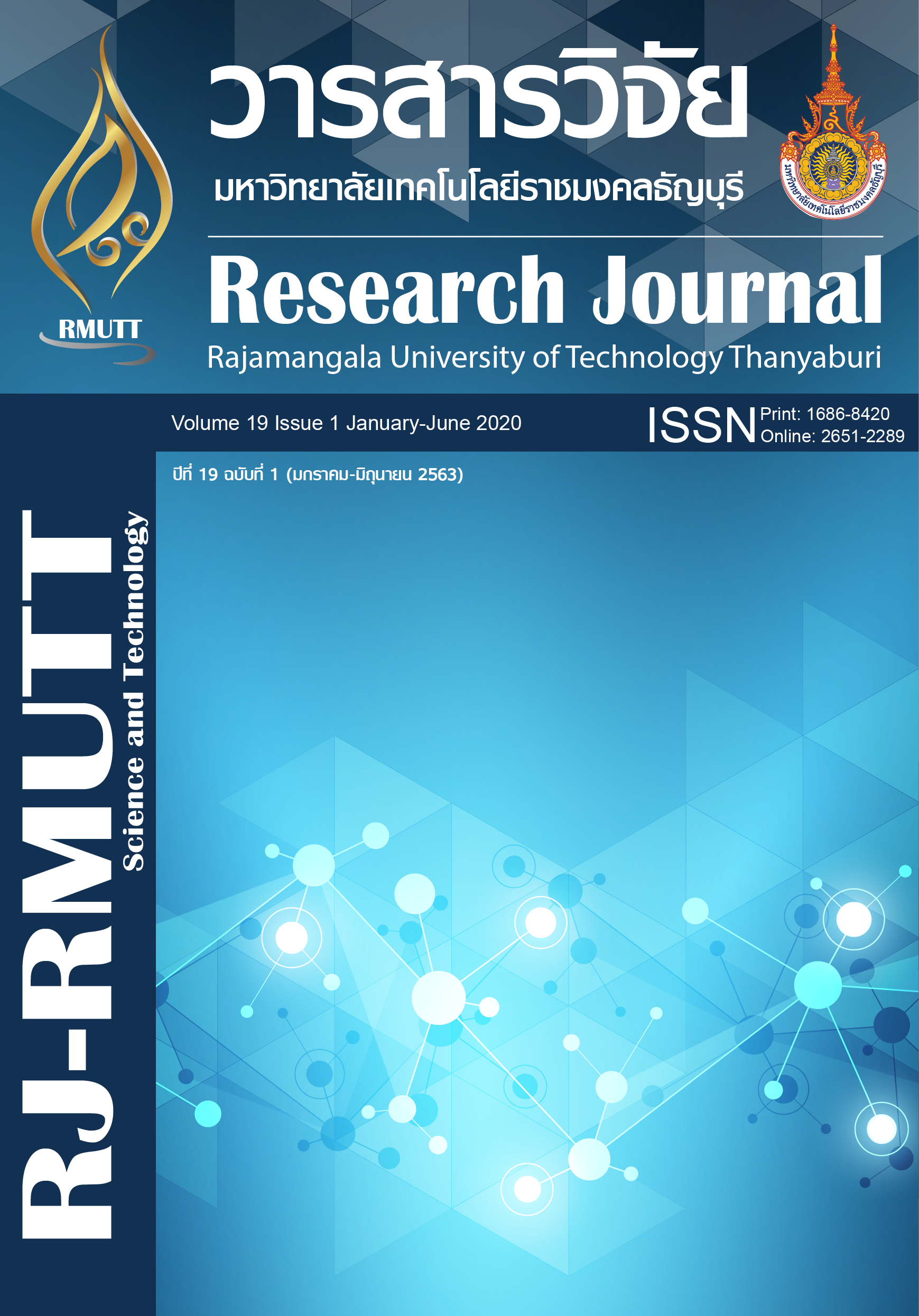Study and Testing of Lotus Leaves Cutting Machine
Main Article Content
Abstract
This research aimed to design and to fabricate a lotus leave cutting machine prototype that can reduce the processing time and labor cost in the lotus leaf cutting process for better lotus leave tea production. This prototype consists of the main frame, conveyor unit, cutting unit, Geneva mechanism, power transmission unit and a prime mover by 150W-gear-motor. The power of the machine started when the operator input the lotus leaves into the hind feeder of the machine. Then the lotus leaves were transported into the cutter set processed by the Geneva mechanism. The cutter set could cut the lotus leaves along the horizontal axis. After that, the lotus leaves were cut into pieces of 44 centimeter and released down to the outlet in front of the machine. The results revealed that the best average cutting speed of blade was 1 meter/minute in 5 layers of lotus leaves among all the trials at different average cutting speed rates of blades 0.5, 0.75 and 1 meter/minute and numbers of 1, 2, 3, 4 and 5 layers, respectively. The cutting percentage was 98.9 % with 1.1 % leaf damage and a working capacity of 8.58 kilograms/hour that consumed 92.4 Watt-hours. The engineering economic analysis showed that on average it cost 5.24 baht/kilogram of lotus leaves at 1,440 hours/year with a 2.8 month payback period and 81.1 hours/year for a break-even point. This prototype could work 4.3 times faster than human labor.
Article Details

This work is licensed under a Creative Commons Attribution-NonCommercial-NoDerivatives 4.0 International License.
References
Lotus production situation. [Internet]. Bangkok: Department of Agriculture Extension. [updated 2017 May 16; cited 2018 Jul 9]. Available from: http://www.doae.go.th/LIBRARY/.
Suwannaro T. Lotus farming. Extension and Training Office. Bangkok: Kasetsart University; 2007.
Mueangsuk S. Lotus farming in Bueng Kan [Internet]. Bangkok: khaosod Online. [updated 2016 Feb; cited 2016 Feb 15]. Available from: https://www.khaosod.co.th
/viewnewsonline.phpnewsid.
Jolly RS. Benefits of the lotus plant [Internet]. Mumbai; [updated 2018 Oct; cited 2019 Jan 25]. Available from: https://
caloriebee.com/nutrition/Health-Benefits-Of-Lotus-Roots-Or-Stem-Seeds-Leaves-And-Flowers.
Fisher S. Top 10 lotus leaf tea health benefits / effects [Internet]. [updated 2017 Oct; cited 2019 Jan 27]. Available from: https:// https://www.airytea.com
/blog/lotus-leaf-tea-health-benefits-effects.
Wikipedia. Lotus tea [Internet]. [updated 2018 Oct; cited 2019 Feb 20]. Available from: https://en.wikipedia.org/wiki/ Lotus-tea
Manojai K. Lotus leaf tea health benefits [Internet]. Bangkok: technologychaoban. [updated 2016 Nov; cited 2019 Feb 15]. Available from: https://www.
technologychaoban.com/newsslide/article-7140.
William H, George WL. Official methods of analysis of AOAC International. 18th ed. Texas. Gaithersburg, Md.: AOAC International, 2005.
จตุรงค์ ลังกาพินธุ์. ทฤษฏีของเครื่องจักรกลเกษตร. พิมพ์ครั้งที่ 1. กรุงเทพฯ: สำนักพิมพ์ทริปเพิ้ล เอ็ดดูเคชั่น จำกัด; 2558.
Krutz G, Thomson L, Claar P. Design of agricultural machinery. 1st ed. New York: John Wiley and Sons; 1994.
Shigley JE, Mischke CR. Mechanical engineering design. 5th ed, USA: McGraw-Hill Book Company; 1989.
จตุรงค์ ลังกาพินธุ์. ออกแบบและเขียนแบบวิศวกรรมด้วยโปรแกรม SolidWorks. พิมพ์ครั้งที่ 3, กรุงเทพฯ: สำนักพิมพ์ทริปเพิ้ล เอ็ดดูเคชั่น จำกัด; 2560.
Hunt D. Farm power and machinery. 10th ed. Iowa, USA: Iowa State University Press; 2001.


